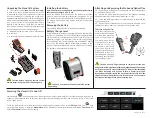
OTHER HAZARDS
PAGE
|
40
Important Note: Always wear safety glasses or protective goggles with side shields to reduce the
risk of damage to the eyes when operating the laser.
Other Hazards
The following hazards are typical for this product family when incorporated for intended use: (A) risk of
injury when lifting or moving the unit; (B) risk of exposure to hazardous laser energy through
unauthorized removal of access panels, doors, or protective barriers; (C) risk of exposure to hazardous
laser energy and injury due to failure of personnel to use proper eye protection and/or failure to adhere
to applicable laser safety procedures; (D) risk of exposure to hazardous or lethal voltages through
unauthorized removal of covers, doors, or access panels; (E) generation of hazardous air contaminants
that may be noxious, toxic, or even fatal.
Warning: Serious Personal Injury
Do not allow laser radiation to enter the eye by viewing direct or reflected laser energy.
CO2 laser radiation can be reflected from metallic objects even though the surface is darkened.
Direct or diffuse laser radiation can inflict severe corneal injuries leading to permanent eye damage
or blindness. All personnel must wear eye protection suitable for 9.3–10.6
μ
m CO2 radiation when
in the same area as an exposed laser beam.
Eye wear protects against scattered energy but is not intended to protect against direct viewing of
the beam—never look directly into the laser output aperture or view scattered laser reflections
from metallic surfaces.
Enclose the beam path whenever possible. Exposure to direct or diffuse CO2 laser radiation can
seriously burn human or animal tissue, which may cause permanent damage.
This product is not intended for use in explosive, or potentially explosive, atmospheres.
Materials processing with a laser can generate air contaminants such as vapors, fumes, and/or
particles that may be noxious, toxic, or even fatal. Material Safety Data Sheets (MSDS) for materials
being processed should be thoroughly evaluated and the adequacy of provisions for fume
extraction, filtering, and venting should be carefully considered. Review the following references for
further information on exposure criteria:
Review the following references for further information on exposure criteria:
ANSI Z136.1-2007, Safe Use of Lasers, section 7.3.
U.S. Government’s Code of Federal Regulations: 29 CFR 1910, Subpart Z.
Threshold Limit Values (TLV’s) published by the American Conference of Governmental Industrial
Hygienists (ACGIH).
It may be necessary to consult with local governmental agencies regarding restrictions on the
venting of processing vapors.
The use of aerosol dusters containing difluoroethane causes “blooming”, a condition that
significantly expands and scatters the laser beam. This beam expansion can affect mode quality
and/or cause laser energy to extend beyond the confines of optical elements in the system,
possibly damaging acrylic safety shielding. Do not use air dusters containing difluoroethane in any
















































